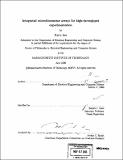| dc.contributor.advisor | Rajeev J. Ram. | en_US |
| dc.contributor.author | Lee, Harry, 1976- | en_US |
| dc.contributor.other | Massachusetts Institute of Technology. Dept. of Electrical Engineering and Computer Science. | en_US |
| dc.date.accessioned | 2007-07-18T13:08:17Z | |
| dc.date.available | 2007-07-18T13:08:17Z | |
| dc.date.copyright | 2006 | en_US |
| dc.date.issued | 2006 | en_US |
| dc.identifier.uri | http://hdl.handle.net/1721.1/37908 | |
| dc.description | Thesis (Ph. D.)--Massachusetts Institute of Technology, Dept. of Electrical Engineering and Computer Science, 2006. | en_US |
| dc.description | Includes bibliographical references (p. 219-226). | en_US |
| dc.description.abstract | Bioprocesses with microbial cells play an important role in producing biopharmaceuticals such as human insulin and human growth hormone, and other products such as amino acids and biopolymers. Because bioprocesses involve the complicated interaction between the genetics of the microorganisms and their chemical and environmental conditions, hundreds or thousands of microbial growth experiments are necessary for to develop and optimize them. In addition, efforts to develop models for bioprocesses also require numerous growth experiments to study microorganism phenotypes. This work describes the design and development of integrated arrays of microbioreactors that can provide the oxygen transfer and control capabilities of a stirred tank bioreactor in a high-throughput format. The devices comprise a novel peristaltic oxygenating mixer and microfluidic injectors, which are fabricated using a process that allows combining multiple scale (100/,m-lcm) and multiple depth (100/im-2mm) structures in a single mold. | en_US |
| dc.description.abstract | (cont.) The microbioreactors have a 100/L working volume, a high oxygen transfer rate (kLa ; 0.1s-1), and closed loop control over dissolved oxygen and pH ( 0.1). Overall, the system supports eight simultaneous batch cultures, in two parallel arrays, with two dissolved oxygen thresholds, individual pH set points, and automated near real-time monitoring of optical density, dissolved oxygen concentration, and pH. These capabilities allowed the demonstration of multiple Escherichia coli aerobic fermentations to high cell densities (>13g-dcw/L), with individual bioreactor performance on par with bench scale stirred tank bioreactors. The successful integration of diverse microfluidic devices and optical sensors in a scalable architecture opens a new pathway for continued development of parallel bioreactor systems. | en_US |
| dc.description.statementofresponsibility | by Harry Lee. | en_US |
| dc.format.extent | 226 p. | en_US |
| dc.language.iso | eng | en_US |
| dc.publisher | Massachusetts Institute of Technology | en_US |
| dc.rights | M.I.T. theses are protected by copyright. They may be viewed from this source for any purpose, but reproduction or distribution in any format is prohibited without written permission. See provided URL for inquiries about permission. | en_US |
| dc.rights.uri | http://dspace.mit.edu/handle/1721.1/7582 | |
| dc.subject | Electrical Engineering and Computer Science. | en_US |
| dc.title | Integrated microbioreactor arrays for high-throughput experimentation | en_US |
| dc.type | Thesis | en_US |
| dc.description.degree | Ph.D. | en_US |
| dc.contributor.department | Massachusetts Institute of Technology. Department of Electrical Engineering and Computer Science | |
| dc.identifier.oclc | 133116157 | en_US |
